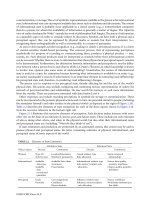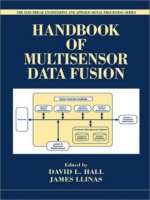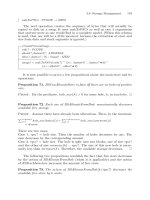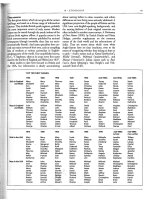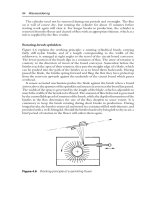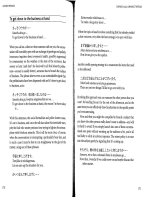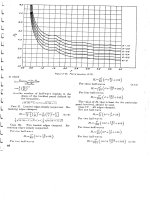handbook of multisensor data fusion phần 4 pot
Bạn đang xem bản rút gọn của tài liệu. Xem và tải ngay bản đầy đủ của tài liệu tại đây (99.21 KB, 3 trang )
©2001 CRC Press LLC
(8.47)
The cumulative set of measurements during the entire period is
(8.48)
The following additional assumptions about the statistical characteristics of the measurements are also
made:
11
1. The measurements at two different sampling instants are conditionally independent, i.e.,
(8.49)
where p[·]is the probability density function.
2. A measurement that originated from the target at a particular sampling instant is received by the
sensor only once during the corresponding scan with probability P
D
and is corrupted by zero-
mean Gaussian noise of known variance. That is
(8.50)
where is the bearing measurement noise. Due to the presence of false measurements,
the index of the true measurement is not known.
3. The false bearing measurements are distributed uniformly in the surveillance region, i.e.,
(8.51)
4. The number of false measurements at a sampling instant is generated according to a Poisson law
with a known expected number of false measurements in the surveillance region. This is deter-
mined by the detection threshold at the sensor (exact equations are given in Section 8.3.5).
For narrowband sonar (with frequency measurements) the target motion model is defined by the
five-dimensional vector
(8.52)
where γ is the unknown emitted frequency assumed constant. Due to the relative motion between the
target and platform at t
i
, this frequency will be Doppler shifted at the platform. The (noise-free) shifted
frequency, denoted by γ
i
(x), is given by
(8.53)
where c is the velocity of sound in the medium. If the bandwidth of the signal processor in the sonar is
[Ω
1
, Ω
2
], the measurements can lie anywhere within this range. As in the case of bearing measurements,
zi a
jijij
()
=
[]
′
∆
β
ZZi
n
i
n
=
()
{}
=
∆
1
pZi Zi x pZi xpZi x i i
12 1 2 12
() ()
[]
=
()
[]
()
[]
∀≠,
βθ
ij i ij
x=
()
+∈
∈
[]
ij
~,ᏺ 0
2
σ
θ
βθθ
ij
~,ᐁ
12
[]
xt t=
() ()
[]
∆
ξηξηγ
11
, ,
˙
,
˙
,
γγ
θθ
ξ
i
iini i
x
vtx x vtx x
c
()
=−
() ()
+
() ()
1
, sin , cos
©2001 CRC Press LLC
9
An Introduction to the
Combinatorics of
Optimal and
Approximate Data
Association
9.1 Introduction
9.2 Background
9.3 Most Probable Assignments
9.4 Optimal Approach
9.5 Computational Considerations
9.6 Efficient Computation of the JAM
9.7 Crude Permanent Approximations
9.8 Approximations Based on Permanent Inequalities
9.9 Comparisons of Different Approaches
9.10 Large-Scale Data Association
9.11 Generalizations
9.12 Conclusions
Acknowledgments
Appendix 9.A Algorithm for Data Association Experiment
References
9.1 Introduction
Applying filtering algorithms to track the states of multiple targets first requires the correlation of the
tracked objects with their corresponding sensor observations. A variety of probabilistic measures can be
applied to each track estimate to determine independently how likely it is to have produced the current
observation; however, such measures are useful only in practice for eliminating obviously infeasible
candidates. Chapter 3 uses these measures to construct gates for efficiently reducing the number of feasible
candidates to a number that can be accommodated within real-time computing constraints. Subsequent
elimination of candidates can then be effected by measures that consider the joint relationships among
the remaining track and report pairs.
After the gating step has been completed, a determination must be made concerning which feasible
associations between observations and tracks are most likely to be correct. In a dense environment,
however, resolving the ambiguities among various possible assignments of sensor reports to tracks may
Jeffrey K. Uhlmann
University of Missouri
©2001 CRC Press LLC
10
A Bayesian Approach
to Multiple-
Target Tracking*
10.1 Introduction
Definition of Bayesian Approach • Relationship to Kalman
Filtering
10.2 Bayesian Formulation of the Single-Target
Tracking Problem
Bayesian Filtering • Problem Definition • Computing the
Posterior • Likelihood Functions
10.3 Multiple-Target Tracking without Contacts or
Association (Unified Tracking)
Multiple-Target Motion Model • Multiple-Target Likelihood
Functions • Posterior Distribution • Unified Tracking
Recursion
10.4 Multiple-Hypothesis Tracking (MHT)
Contacts, Scans, and Association Hypotheses • Scan and Data
Association Likelihood Functions • General Multiple-
Hypothesis Tracking • Independent Multiple-Hypothesis
Tracking
10.5 Relationship of Unified Tracking to MHT and
Other Tracking Approaches
General MHT Is a Special Case of Unified Tracking •
Relationship of Unified Tracking to Other Multiple-Target
Tracking Algorithms • Critique of Unified Tracking
10.6 Likelihood Ratio Detection and Tracking
Basic Definitions and Relations • Likelihood Ratio Recursion •
Log-Likelihood Ratios • Declaring a Target Present • Track-
Before-Detect
References
10.1 Introduction
This chapter views the multiple-target tracking problem as a Bayesian inference problem and highlights
the benefits this approach. The goal of this chapter is to provide the reader with some insights and
perhaps a new view of multiple-target tracking. It is not designed to provide the reader with a set of
algorithms for multiple-target tracking.
*This chapter is based on
Bayesian Multiple Target Tracking,
by Stone, L. D., Barlow, C. A., and Corwin, T. L.,
1999. Artech House, Inc., Norwood, MA. www.artechhouse.com.
Lawrence D. Stone
Metron Inc.
